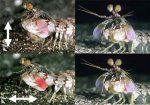Secret Communication Channels in the Ocean: Polarization Vision
Justin Marshall
Vision Touch and Hearing Research Centre, QBI, University of Queensland, Australia
Tom Cronin
Department of Biological Sciences, UMBC, Baltimore, MD
Sonke Johnsen
Assistant Professor, Duke University
Humans only think about polarized light when reaching for a pair of sunglasses on a boat or in a car to reduce water glare. In these and other situations, having a polarized filter in front of the eye can make objects that are otherwise difficult to see more apparent.
Evolutionary Sunglasses
It may be no surprise therefore to discover that, as is often the case, animals have 'invented' the same technology, only millions of years ago and through processes such as evolution. Many animals -- such as fish, insects, birds, crabs and even shrimps -- have wonderfully well tuned polarization vision to help them solve problems and perform their daily tasks. Studies are underway on these tasks and the ways in which 'nature's technology' solves these problems.
The first thing to realize (and wearing a pair of polarized sunglasses can help with this) is that polarized light is prevalent in the world, reflected off shiny surfaces like water and leaves, in hazy environments and even produced by animals themselves.
Scientists have been surprised in recent years to discover how many animals rely on polarization vision and the variety of possible uses for it. These include navigation using polarized patterns in the sky, finding food, communicating with mates and rivals and camouflage breaking.
Polarization in the Ocean
While a fair bit of work has examined polarization vision, particularly in insects on land, less attention has focused on the oceans and other aquatic environments. By using the Johnson-Sea-Link submersibles, the team on the Deep Scope exploration will study the type of polarized light found on the dive sites and look at the animals that live there to see if they have secrets such as those seen in the mantis shrimps.
For many animals living in the oceans, sensing polarization may be even more important than sensing color. One possible use for polarization in the ocean and elsewhere is signaling -- communicating with neighbors, rivals and potential partners. Recent discoveries have shown that stomatopods, a sort of shrimp found on reefs around the world, use special body areas to communicate with polarized light. These can only be seen by human eyes with polarizing filters.
Polarizing Shrimp
Photographs of mantis shrimps using polarizing filters reveal areas of the body that are thought to be used for "secret communication". They are only visible to animals that can see polarized light and stomatopods are among the best in the animal kingdom. What are these red colored / polarized areas used for?
So little is known about this 'extrasensory' (in human terms) sense, that a world of discovery awaits. We only need to look around and there will be plenty of exciting things to find. Several clues suggest that many of the animals from the deep-sea use polarized light and polarization vision more than color. Using the Johnson-Sea-Link submersibles will help follow these leads and decode the secret mysteries of the deep. Every time we go down we find something new.
from the Ocean Explorer
Justin Marshall
Vision Touch and Hearing Research Centre, QBI, University of Queensland, Australia
Tom Cronin
Department of Biological Sciences, UMBC, Baltimore, MD
Sonke Johnsen
Assistant Professor, Duke University
Humans only think about polarized light when reaching for a pair of sunglasses on a boat or in a car to reduce water glare. In these and other situations, having a polarized filter in front of the eye can make objects that are otherwise difficult to see more apparent.
Evolutionary Sunglasses
It may be no surprise therefore to discover that, as is often the case, animals have 'invented' the same technology, only millions of years ago and through processes such as evolution. Many animals -- such as fish, insects, birds, crabs and even shrimps -- have wonderfully well tuned polarization vision to help them solve problems and perform their daily tasks. Studies are underway on these tasks and the ways in which 'nature's technology' solves these problems.
The first thing to realize (and wearing a pair of polarized sunglasses can help with this) is that polarized light is prevalent in the world, reflected off shiny surfaces like water and leaves, in hazy environments and even produced by animals themselves.
Scientists have been surprised in recent years to discover how many animals rely on polarization vision and the variety of possible uses for it. These include navigation using polarized patterns in the sky, finding food, communicating with mates and rivals and camouflage breaking.
Polarization in the Ocean
While a fair bit of work has examined polarization vision, particularly in insects on land, less attention has focused on the oceans and other aquatic environments. By using the Johnson-Sea-Link submersibles, the team on the Deep Scope exploration will study the type of polarized light found on the dive sites and look at the animals that live there to see if they have secrets such as those seen in the mantis shrimps.
For many animals living in the oceans, sensing polarization may be even more important than sensing color. One possible use for polarization in the ocean and elsewhere is signaling -- communicating with neighbors, rivals and potential partners. Recent discoveries have shown that stomatopods, a sort of shrimp found on reefs around the world, use special body areas to communicate with polarized light. These can only be seen by human eyes with polarizing filters.
Polarizing Shrimp
Photographs of mantis shrimps using polarizing filters reveal areas of the body that are thought to be used for "secret communication". They are only visible to animals that can see polarized light and stomatopods are among the best in the animal kingdom. What are these red colored / polarized areas used for?
So little is known about this 'extrasensory' (in human terms) sense, that a world of discovery awaits. We only need to look around and there will be plenty of exciting things to find. Several clues suggest that many of the animals from the deep-sea use polarized light and polarization vision more than color. Using the Johnson-Sea-Link submersibles will help follow these leads and decode the secret mysteries of the deep. Every time we go down we find something new.
from the Ocean Explorer







